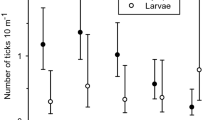Abstract
The purpose of this study was to compare the trapping and examining of mice, drag sampling, and CO2-baited traps for their ability to detect the presence and abundance of immature deer ticks,Ixodes dammini, in a Lyme disease endemic area in southern New York State. Eight study sites were sampled 14 times between 28 May and 31 August by setting 49 live-traps, four CO2-baited traps, and drag sampling 500 m2. A total of 1540 nymphs and 3079 larvae was collected during the study. Drag sampling collected the most nymphs (705), while more larvae were recovered from CO2-baited traps (1105). Comparisons among the methods showed a significant difference in the numbers of both larval and nymphal ticks collected (P<0.01). There was a positive correlation between the numbers of nymphs collected by drag sampling and CO2-baited tick traps (r s=0.83,P<0.05), and between the numbers of larvae collected by drag sampling and mouse trapping (r s=0.75,P<0.05). These results suggest that drag sampling would be the single most reliable method for quantitatively sampling immatureI. dammini populations in a Lyme disease endemic area.
Similar content being viewed by others
References
Anderson, J.F. and Magnarelli, L.A., 1980. Vertebrate host relationships and distribution of ixodid ticks (Acari: Ixodidae) in Connecticut, USA. J. Med. Entomol., 17: 314–323.
Anderson, J.F., Magnarelli, L.A. and Stafford, K.C., 1990. Bird-feeding ticks transstadially transmitBorrelia burgdorferi that infect Syrian hamsters. J. Wildl. Dis. 26: 1–10.
Battaly, G.R., Fish, D. and Dowler, R.C., 1987. The seasonal occurrence ofIxodes dammini andIxodes dentatus (Acari: Ixodidae) on birds in a Lyme disease endemic area of southeastern New York State. J. NY Entomol. Soc., 95:461–468.
Burgdorfer, W., Barbour, A.G., Hayes, S.F., Benach, J.L., Grunwaldt, E. and Davis, J.P., 1982. Lyme disease — a tick-borne spirochetosis? Science, 216: 1317–1319.
Centers for Disease Control, 1991. Lyme disease surveillance-United States, 1989–1990. Morb. Mortal. Wkly. Rep., 40: 417–420.
Falco, R.C. and Fish, D., 1988. Prevalence ofIxodes dammini near the homes of Lyme disease patients in Westchester County, New York. Am. J. Epidemiol., 127: 826–830.
Falco, R.C. and Fish, D., 1989a. Potential for exposure to tick bites in recreational parks in a Lyme disease endemic area. Am. J. Public Health, 79: 12–15.
Falco, R.C. and Fish, D., 1989b. The use of carbon dioxide-baited tick traps for samplingIxodes dammini (Acari: Ixodidae). Acarologia, 30: 29–33.
Fish, D. and Dowler, R.C., 1989. Host associations of ticks (Acari: Ixodidae) parasitizing medium-sized mammals in a Lyme disease endemic area of southern New York State. J. Med. Entomol., 26: 200–209.
Ginsberg, H.S. and Ewing, C.P., 1989. Comparison of flagging, walking, trapping, and collecting from hosts as sampling methods for northern deer ticks,Ixodes dammini, and lone-star ticks,Amblyomma americanum (Acari: Ixodidae). Exp. Appl. Acarol., 7: 313–322.
Gray, J.S., 1985. A carbon dioxide trap for prolonged sampling ofIxodes ricinus L. populations. Exp. Appl. Acarol., 1: 35–44.
Green, R.H., 1979. Sampling design and statistical methods for environmental biologists. John Wiley and Sons, New York, NY, 257 pp.
Koch, H.G. and McNew, R.W., 1982. Sampling of lone star ticks (Acari: Ixodidae): dry ice quantity and capture success. Ann. Entomol. Soc. Am., 75: 579–582.
Magnarelli, L.A., Anderson, J.F., Apperson, C.S., Fish, D., Johnson, R.C. and Chappell, W.A., 1986. Spirochetes in ticks and antibodies toBorrelia burgdorferi in white-tailed deer from Connecticut, New York State, and North Carolina. J. Wildl. Dis., 22: 178–188.
Main, A.J., Carey, A.B., Carey, M.G. and Goodwin, R.H., 1982. ImmatureIxodes dammini (Acari: Ixodidae) on small mammals in Connecticut, USA. J. Med. Entomol., 19: 655–664.
Matuschka, F.R. and Spielman, A., 1986. The emergence of Lyme disease in a changing environment in North America and Central Europe. Exp. Appl. Acarol., 2: 337–353.
Milne, A., 1943. The comparison of sheep-tick populations (Ixodes ricinus L.). Ann. Appl. Biol., 30: 240–250.
Piesman, J., 1989. Transmission of Lyme disease spirochetes (Borrelia burgdorferi). Exp. Appl. Acarol., 7:71–80.
Piesman, J. and Spielman, A., 1979. Host-associations and seasonal abundance of immatureIxodes dammini in southeastern Massachusetts. Ann. Entomol. Soc. Am., 72: 829–832.
Sokal, R.R. and Rohlf, F.J., 1981. Biometry, 2. Freeman, San Francisco, CA, 859 pp.
Spielman, A., Wilson, M.L., Levine, J.F. and Piesman, J., 1985. Ecology ofIxodes dammini-borne human babesiosis and Lyme disease. Ann. Rev. Entomol., 30: 439–460.
Steere, A.C. and Malawista, S.E., 1979. Cases of Lyme disease in the United States: Locations correlated with the distribution ofIxodes dammini. Ann. Intern. Med., 91: 730–733.
Steere, A.C., Broderick, T.E. and Malawista, S.E., 1978. Erythema chronicum migrans and Lyme arthritis: epidemiologic evidence for a tick vector. Am. J. Epidemiol., 108: 312–321.
Wallis, R.C., Brown, S.F., Klotter, K.O. and Main, A.J., 1978. Erythema chronicum migrans and Lyme arthritis: field study of ticks. Am. J. Epidemiol., 108: 322–327.
Williams, C.L., Curran, A.S., Lee, A.C. and Sousa, V.O., 1986. Lyme disease: epidemiologic characteristics of an outbreak in Westchester County, N.Y.. Am. J. Pub. Health, 76: 62–65.
Wilson, J.G., Kinzer, D.R., Sauer, J.R. and Hair, J.A., 1972. Chemo-attraction in the lone star tick (Acarina: Ixodidae). I. Response of different developmental stages to carbon dioxide administered via traps. J. Med. Entomol., 9: 245–252.
Wilson, M.L. and Spielman, A., 1985. Seasonal activity of immatureIxodes dammini (Acari: Ixodidae). J. Med. Entomol., 22: 408–414.
Wilson, M.L., Levine, J.F. and Spielman, A., 1984. Effect of deer reduction on abundance of the deer tick (Ixodes dammini). Yale J. Biol. Med., 57: 697–705.
Author information
Authors and Affiliations
Rights and permissions
About this article
Cite this article
Falco, R.C., Fish, D. A comparison of methods for sampling the deer tick,Ixodes dammini, in a Lyme disease endemic area. Exp Appl Acarol 14, 165–173 (1992). https://doi.org/10.1007/BF01219108
Accepted:
Issue Date:
DOI: https://doi.org/10.1007/BF01219108




